
Chapter 4: Greek Art
Key Notes
Time Period
Greek Archaic Art : 600–480 B.C.E.
Greek Classical Art : 480–323 B.C.E.
Greek Hellenistic Art : 323–30 B.C.E.
Culture, beliefs, and physical settings
Ancient Greek art was primarily produced in what is today Greece, Turkey, and Italy.
Greek art is studied chronologically according to changes in style.
Greek culture is rich in written literature: i.e., epics, poetry, dramas.
Greek art is known for its idealization and harmonious proportions, both in sculpture and in architecture.
Cultural Interactions
There is an active exchange of artistic ideas throughout the Mediterranean.
Ancient Greek objects were influenced by Egyptian and Near Eastern works.
Audience, functions and patron
Ancient Greek art is influenced by civic responsibility and the polytheism of its religion.
Theories and Interpretations
The study of art history is shaped by changing analyses based on scholarship, theories, context, and written records.
Greek art has had an important impact on European art, particularly since the eighteenth century.
Greek writing contains some of the earliest contemporary accounts about art and artists.
Historical Background
The collapse of Aegean society around 1100 B.C.E. left a vacuum in the Greek world until a reorganization took place around 900 B.C.E. in the form of city-states.
Places like Sparta, Corinth, and Athens defined Greek civilization in that they were small, competing for political entities that were united only in language and the fear of outsiders.
In the fifth century B.C.E. the Persians threatened to swallow Greece, and the city-states rallied behind Athens’ leadership to expel them.
This was accomplished, but not before Athens itself was destroyed in 480 B.C.E.
After the Persians were effectively neutralized, the Greeks then turned, once again, to bickering among themselves.
The worst of these internal struggles happened during the Peloponnesian War (431–404 B.C.E.) when Athens was crushed by Sparta.
Without an effective core, Greek states continued to struggle for another century.
This did not end until the reign of Alexander the Great, who, in the fourth century B.C.E., briefly united Macedonians and Greeks, by establishing a mighty empire that eventually toppled the Persians.
Because Alexander died young and left no clear successor, his empire crumbled away soon after his death.
The remnants of Greek civilization lasted a few hundred years more until it was eventually absorbed by Rome.
Patronage and Artistic Life
So many names of artists have come down to us that it is tempting to think that Greek artists achieved a distinguished status hitherto unknown in the ancient world.
Artists signed their work, both as a symbol of accomplishment and as a bit of advertisement.
Greek potters and painters signed their vases, usually in a formula that resembles “so and so made it” or “so and so decorated it.”
Many artists were theoreticians as well as sculptors or architects.
Polykleitos: He wrote a famous (no longer existing) book on the canon of human proportions.
Iktinos: He wrote on the nature of ideal architecture.
Phidias He who was responsible for the artistic program on the Acropolis, supervised hundreds of workers in a mammoth workshop and yet still managed to construct a complex with a single unifying artistic expression.
Greek Sculpture
Greek sculpture is unafraid of nudity.
At first, only men are shown as nude; gradually women are also depicted, although there is a reluctance to fully accept female nudity, even at the end of the Greek period.
Large Greek marble sculptures are cut away from the stone behind them.
Large-scale bronze works were particularly treasured; their lighter weight made compositional experiments more ambitious.
Greek art in the Classical and Hellenistic periods use contrapposto, which is a relaxed way of standing with knees bent and shoulders tilted.
Contrapposto: a graceful arrangement of the body based on tilted shoulders and hips and bent knees
Greek Archaic Sculpture
Marble: It is the stone of choice, although Greek works survive in a variety of materials: bronze, limestone, terra cotta, wood, gold—even iron.
Sculpture was often painted, especially if it were to be located high on the temple façade.
Bronze sculpture is hollow and made in the lost-wax process, call cire perdue.
Kouros and kore figures stand frontally, bolt upright, and with squarish shoulders.
Hair is knotted, and the ears are a curlicue.
Figures are cut free from the stone as much as possible, although arms are sometimes attached to thighs.
➼ Anavysos Kouros
Details
From Archaic Greek
c. 530 B.C.E.
A marble with remnants of paint
Found in National Archaeological Museum, Athens
Kouros (female: kore): An archaic Greek sculpture of a standing youth
Form
Emulates the stance of Egyptian sculpture but is nude; arms and legs are largely cut free from the stone.
Rigidly frontal.
Freestanding and able to move; in contrast, many Egyptian works are reliefs or are attached to the stone.
Hair is knotted and falls in neatly braided rows down the back.
Some paint survives, some of it encaustic, which would have given the sculpture greater life.
Encaustic: a type of painting in which colors are added to hot wax to affix to a surface
“Archaic smile” meant to enliven the sculpture.
Function
Grave marker, replacing huge vases of the Geometric period.
Sponsored by an aristocratic family.
Content
Not a real portrait but a general representation of the dead.
Named after a young military hero, Kroisos; the inscription at the base identifies him: “Stand and grieve at the tomb of Kroisos, the dead, in the front line slain by the wild Ares.”
Image

➼ Peplos Kore
Details
From the Acropolis, Archaic Greek
c. 530 B.C.E.
A marble and painted details
Found in Acropolis Museum, Athens
Peplos: a garment worn by women in ancient Greece, usually full length and tied at the waist
Form
Hand emerges into the viewer’s space, breaks out of the mold of static Archaic statues.
Indented waist.
Breasts revealed beneath drapery.
Rounded and naturalistic face.
Much of the encaustic paint still remains, animating the face and hair.
Broken hand was fitted into the socket and probably held an attribute; she may have been a goddess.
Context: She is named for the peplos, thought to be one of the four traditional garments she is wearing.
Theory
Recent theory proposes that she is the goddess, either Athena or Artemis; the figure is now missing arrows and a bow in her hand, and she may have worn a metal diadem on her head.
Image
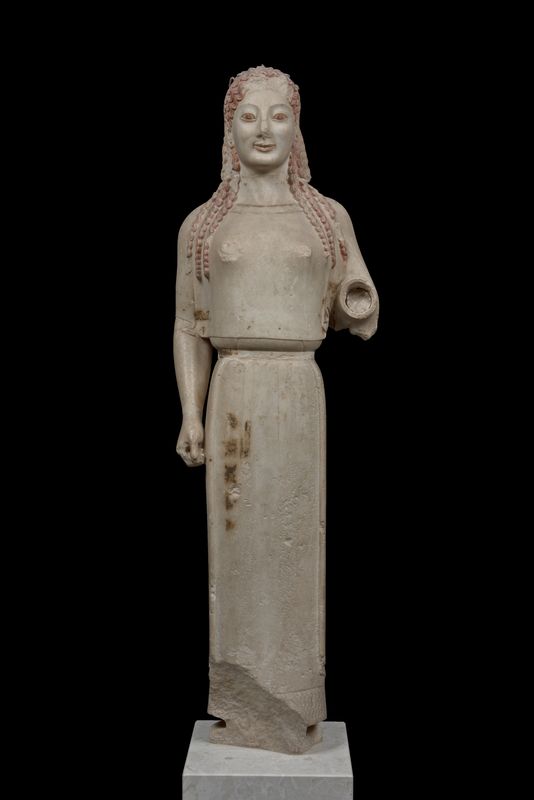
Greek Classical Sculpture
Contrapposto: The fluid body movement and relaxed stance that was unknown in freestanding sculpture before this.
In the fifth century B.C.E., this heroic form was defined by Polykleitos, a sculptor whose canon of proportions of the human figure had far-reaching effects.
Canon: a body of rules or laws; in Greek art, the ideal mathematical proportion of a figure
He wrote that the head should be one-seventh of the body.
He preferred heavy musculature with alternating relaxed and stressed muscle stances.
On Spear Bearer (450–440 B.C.E.), the right arm and the left leg are flexed, and the left arm and right leg are relaxed.
In the Late Classical period of the fourth century B.C.E., gods were sculpted in a more humanized way.
Praxiteles, the greatest sculptor of his age, carved figures with a sensuous and languorous appeal and favored a lanky look to the bodies.
➼ Doryphoros (Spear Bearer)
Details
A sculpture of Polykleitos
original: c. 450–440 B.C.E.
A Roman marble copy of a Greek bronze original,
Found in National Archaeological Museum, Naples
Form
Blocky solidity.
Closed stance.
Broad shoulders, thick torso, muscular body.
Idealized body; contrapposto.
Body is both tense and relaxed: left arm and right leg are relaxed, right arm and left leg are tense.
Content
Warrior and athlete.
Hand once held a spear.
Movement is restrained; ideal Spartan body.
Averted gaze; he does not recognize the viewer’s admiration.
Contemplative gaze.
Context: Represents Polykleitos’s ideal masculine figure.
History
Marble Roman copy of a bronze Greek original.
Found in Pompeii in a place for athletic training, perhaps for inspiration for athletes.
Image
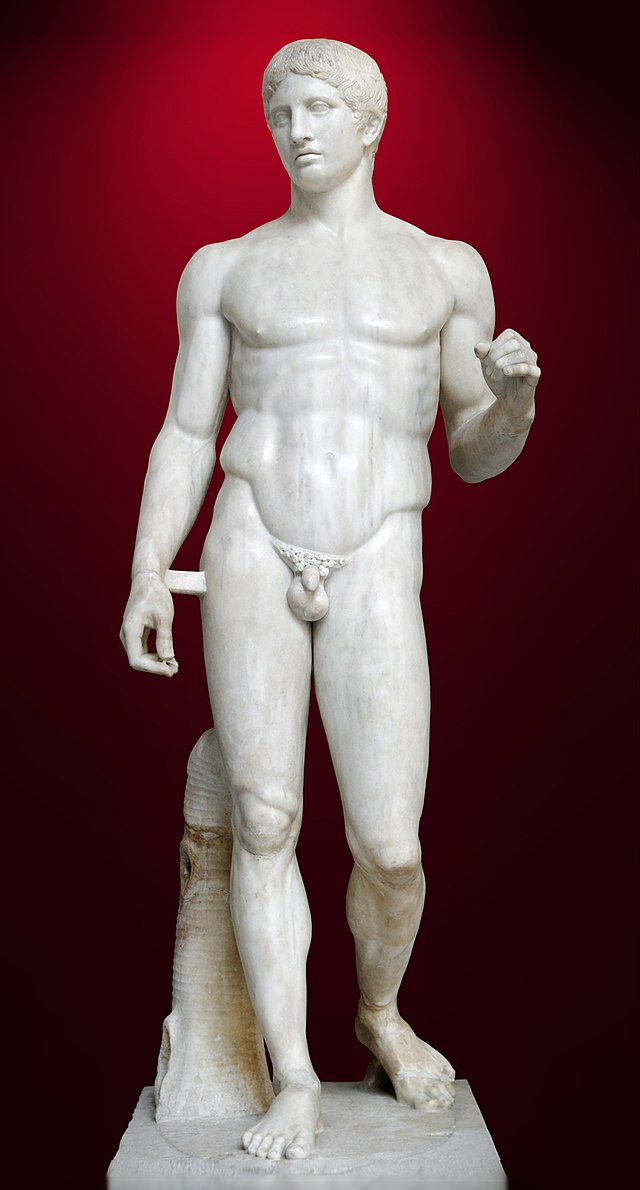
➼ Helios, Horses, and Dionysus (Heracles?)
Details
c. 438–432 B.C.E.
Made up of marble
Found in British Museum, London
Form
Greek Classical art; contrapposto.
Figures seated in the left-hand corner of the east pediment of the Parthenon
Sculptures comfortably sit in the triangular space of the pediment.
Function
Part of the east pediment of the Parthenon.
This grouping contains figures who are present at the birth of Athena, which is the main topic at the center of pediment—now lost.
Content
On the left, the sun god, Helios, bringing up the dawn with his horses; the male nude is Dionysus, god of wine, and he is lounging.
Two seated figures may be the goddesses Demeter and Persephone, reacting to the birth of Athena.
Context
Part of the Parthenon sculptures, also called the Elgin Marbles.
Phidias acted as the chief sculptor of the workshop.
Image
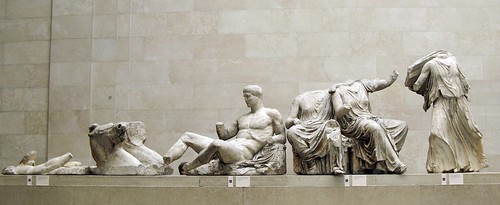
➼ Plaque of the Ergastines
Details
c. 447–438 B.C.E.
Made up of marble
Found in Louvre, Paris
Form
Isocephalism: the tradition of depicting heads of figures on the same level.
Figures stand in contrapposto.
Carved in high relief, which reflects placement; the more three-dimensional the relief, the better it could be seen from below.
Content: Six ergastines, young women in charge of weaving Athena’s peplos, are greeted by two priests.
Context
Part of a frieze from the Parthenon that depicts some 360 figures.
Frieze: a horizontal band of sculpture
Scene from the Panathenaic Frieze depicting the Panathenaic Procession, held every four years to honor Athena.
Panathenaic Way: a ceremonial road for a procession built to honor Athena during a festival
This is the first time in Greek art that human events are depicted on a temple.
The scene contains a religious procession of women dressed in contemporary drapery and acting nobly.
The procession began at the Dipylon Gate, passed through the agora, and ended at the Parthenon.
Athenians placed new peplos on an ancient statue of Athena.
Theory: Not the Panathenaic procession but the story of the legendary Athenian king Erechtheus, who sacrificed one of his daughters to save the city of Athens; told to do so by the Oracle of Delphi.
Image
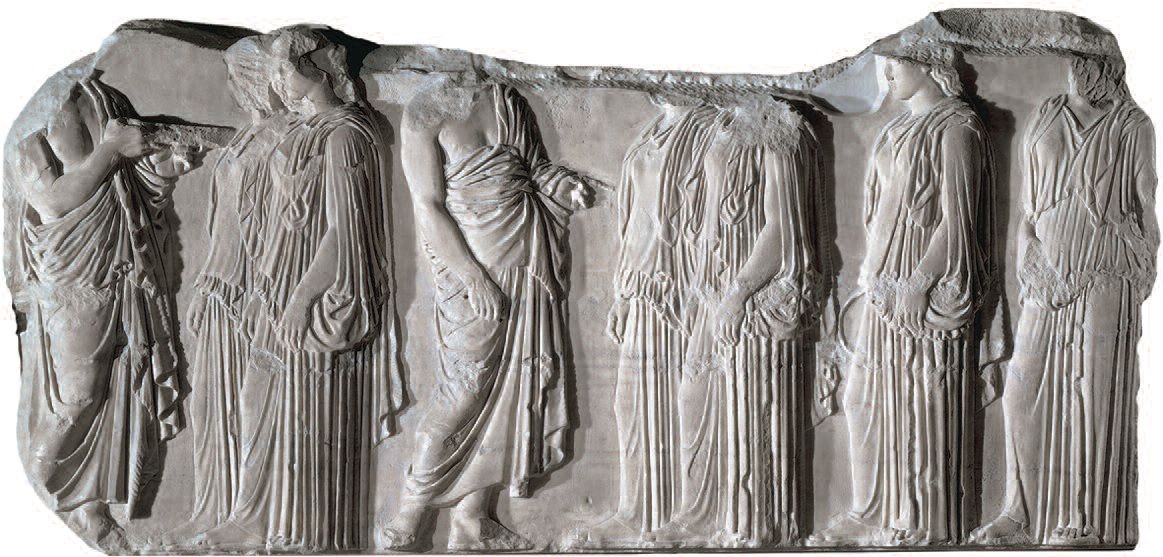
➼ Victory Adjusting Her Sandal
Details
From the Temple of Athena Nike
c. 410 B.C.E.
Made up of marble
Found in Acropolis Museum, Athens
Nike: ancient Greek goddess of victory
Form
Graceful winged figure modeled in high relief.
Deeply incised drapery lines reveal body; wet drapery.
Context
Part of the balustrade on the Temple of Athena Nike, a war monument.
One of many figures on the balustrade; not a continuous narrative but a sequence of independent scenes.
The importance of military victories was stressed in the images on the Acropolis.
Image
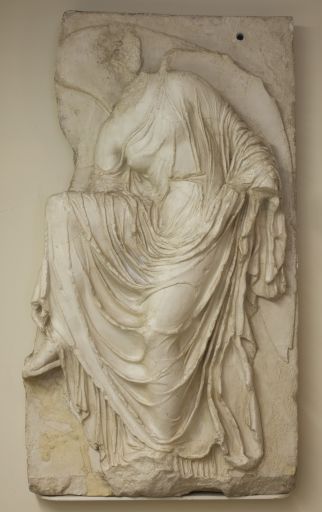
➼ Grave Stele of Hegeso
Details
Attributed to Kallimachos
c. 410 B.C.E.
Made up of marble and paint
Found in National Archaeological Museum, Athens
Stele: an upright stone slab used to mark a grave or a site
Form
Classical period of Greek art.
Use of contrapposto in the standing figure.
Jewelry painted in, not visible.
Architectural framework.
Text includes name of the deceased.
Function
Grave marker.
In Geometric and Archaic periods, Greeks used kraters and kouroi to mark graves; in the Classical period, stelae were used.
Content
Commemorates the death of Hegeso; an inscription identifies her and her father.
Genre scene is that Hegeso examines a piece of jewelry from a jewelry box handed to her by a standing servant; may represent her dowry.
Standing figure has a lower social station, placed before a seated figure.
Context
Erected in the Dipylon cemetery in Athens.
Attributed to the sculptor Kallimachos.
Image
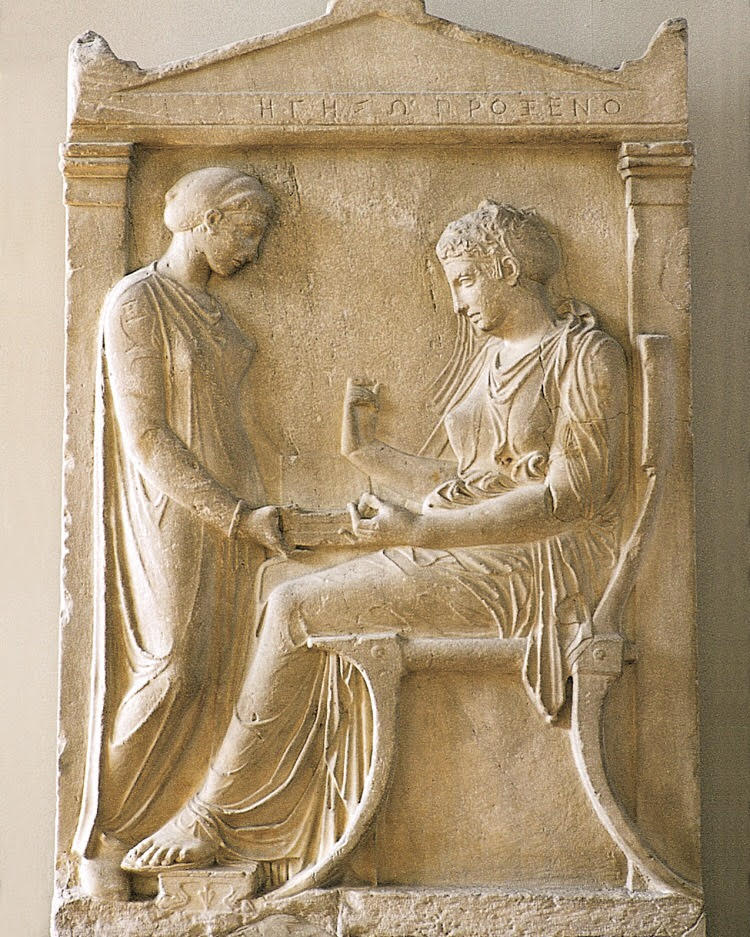
Greek Hellenistic Sculpture
Figures have a great variety of expressions from sadness to joy.
Themes untouched before, such as childhood, old age, despair, anger, and drunkenness, are common subjects in Hellenistic art.
➼ Winged Victory of Samothrace
Details
Hellenistic Greek
c. 190 B.C.E.
Made up of marble
Found in Louvre, Paris
Form
Monumental figure.
Dramatic twist and contrapposto of the torso.
Wet drapery look imitates water playing on the wet body.
Illusion of wind on the body.
Function: Meant to sit on a fountain representing a figurehead on a boat; the fountain would splash water around the figure.
Content
Large heroic figure of Nike placed above the marble prow of a naval vessel.
Nike is wearing several garments, some of which are folded inside out to show the force of the wind.
Nike may have held a trumpet, wreath, or fillet in her right hand. However, the hand found in Samothrace in 1950 has an open palm and two outstretched fingers, indicating that she was simply greeting.
Context
Probably made to commemorate a naval victory in 191 B.C.E.; Nike is the goddess of victory.
The boat at the base is an ancient battleship with oar boxes and traces of a ram.
History
Found in 1863 in situ on Samothrace.
Reassembled in the Louvre Museum in Paris and placed at the top of a grand staircase.
Only one wing was found; the other is a mirror image.
Only one breast was found; the other is a reconstruction.
The right hand has been found, but it cannot be attached because no arms have been found.
Image
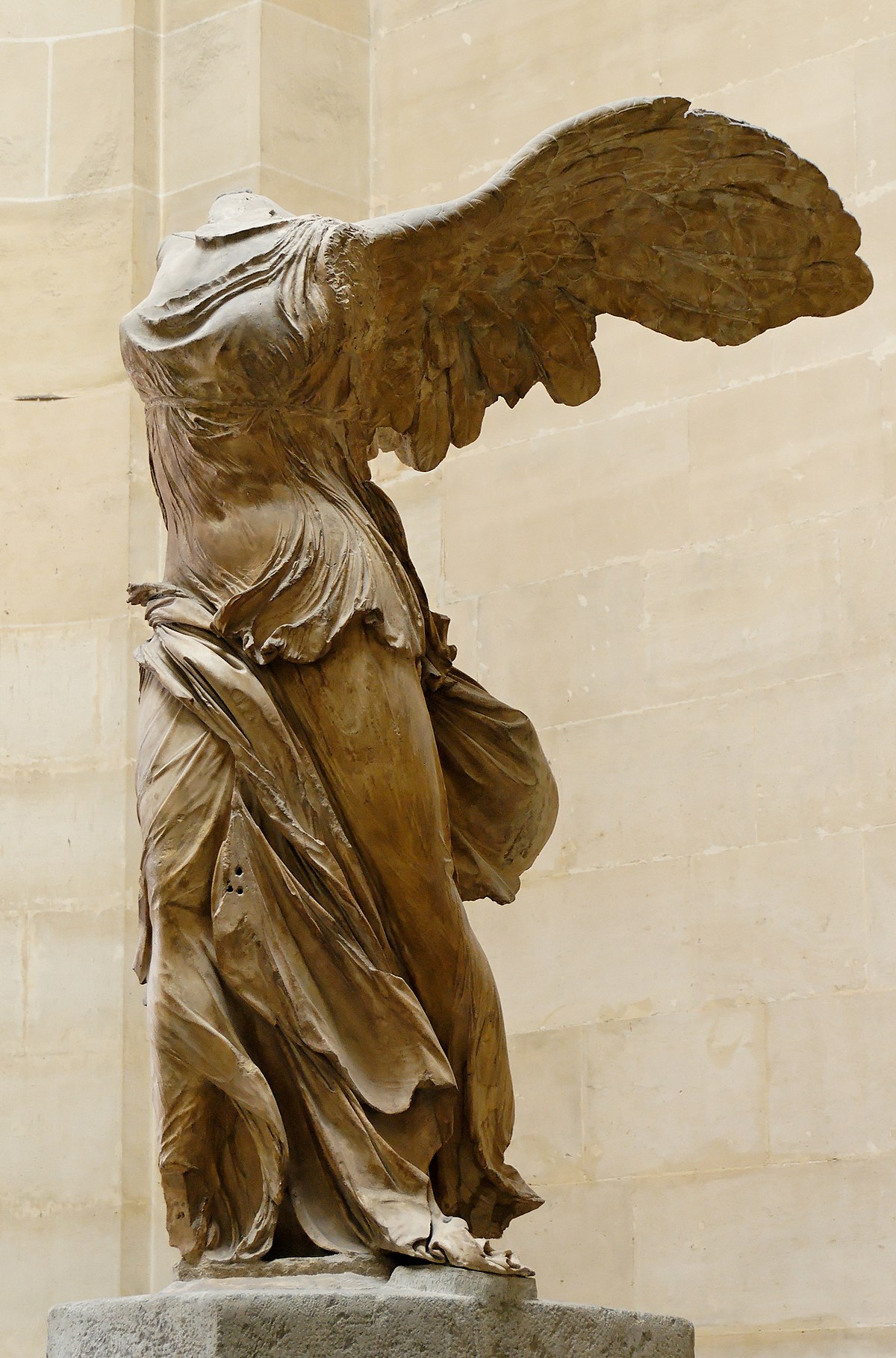
➼ Athena, from the Great Altar of Zeus and Athena at Pergamon
Details
Hellenistic Greek
c. 175 B.C.E.
Made up of marble
Found in Pergamon Museum, Berlin
Athena: Greek goddess of war and wisdom; patron of Athens
Zeus: King of the ancient Greek gods; known as Jupiter to the Romans; god of the sky and weather
Form
Deeply carved figures overlap one another; masterful handling of spatial illusion; figures break into the viewer’s space from the frieze.
Dramatic intensity of figures and movement; heroic musculature.
Function
Gigantomachy on the base of the Pergamon Altar illustrates the victories of the goddess Athena, who is worshipped at the altar.
Gigantomachy: a mythical ancient Greek war between the giants and the Olympian gods
Content
Describes the battle between the gods and the giants; the giants, depicted as helpless, are dragged up the stairs to worship the gods.
Athena grabs Alkyoneos by the hair and drags him up the stair to worship Zeus.
Nike, on the right, crowns Athena in victory.
Gaia, the earth goddess, looks on in horror and pleads for the fate of her sons, the giants.
Context
The gods’ victory over the giants offers a parallel to Alexander the Great’s defeat of the Persians.
Also acts as an allegory of a Greek military victory by Eumenes II.
Image
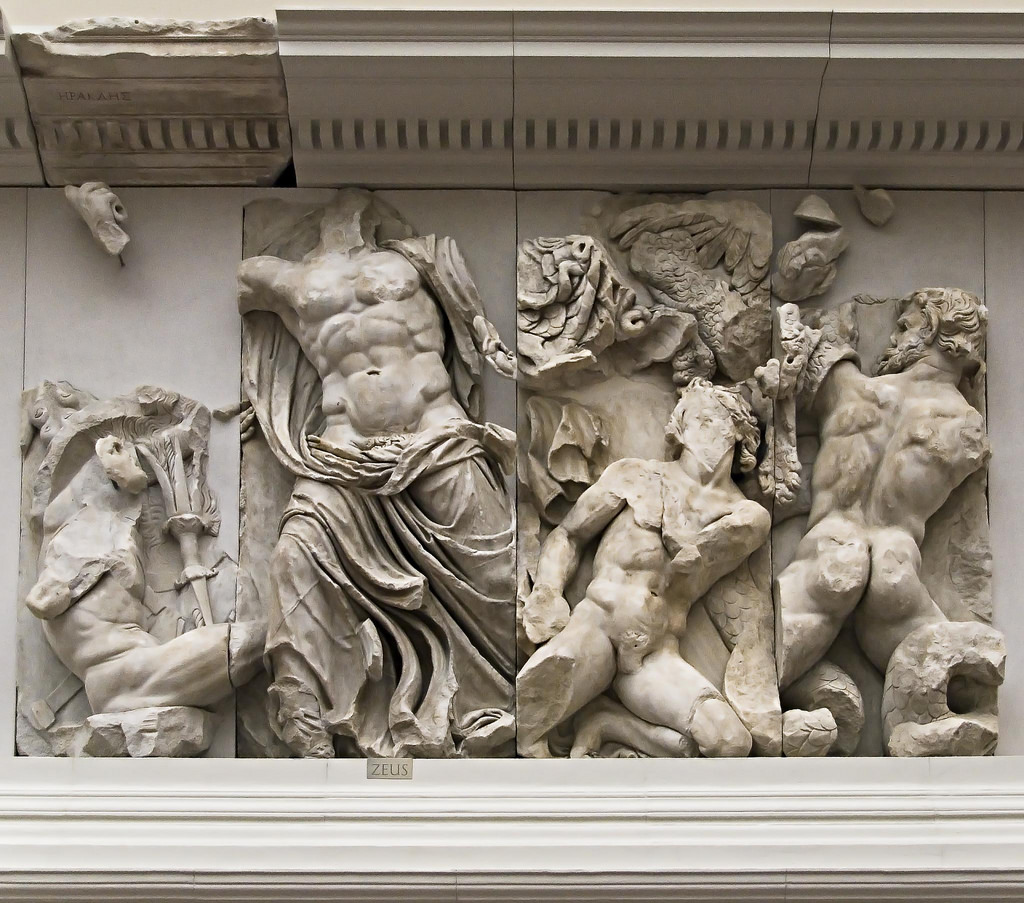
➼ Seated Boxer
Details
Hellenistic Greek
c. 100 B.C.E.
Made up of bronze
Found in National Roman Museum, Rome
Form
Older man, past his prime, looks defeated.
Smashed nose; lips sunken in suggesting broken teeth.
Cauliflower ears.
Nude fighter; hands wrapped in leather bands.
Figure evinces sadness, stoicism and determination.
Function: May have been a good luck charm for athletes; evidence of toes worn away from being touched.
Materials
Rare surviving Hellenistic bronze.
Blood, denoted in copper, drips from his face and onto his right arm and thigh.
Copper used to highlight his lips and nipples, the straps on his leather gloves, and the wounds on his head.
Context
May have been part of a group or perhaps a single sculpture, the head turned to face an unseen opponent.
Found in a Roman bath in Rome.
Image
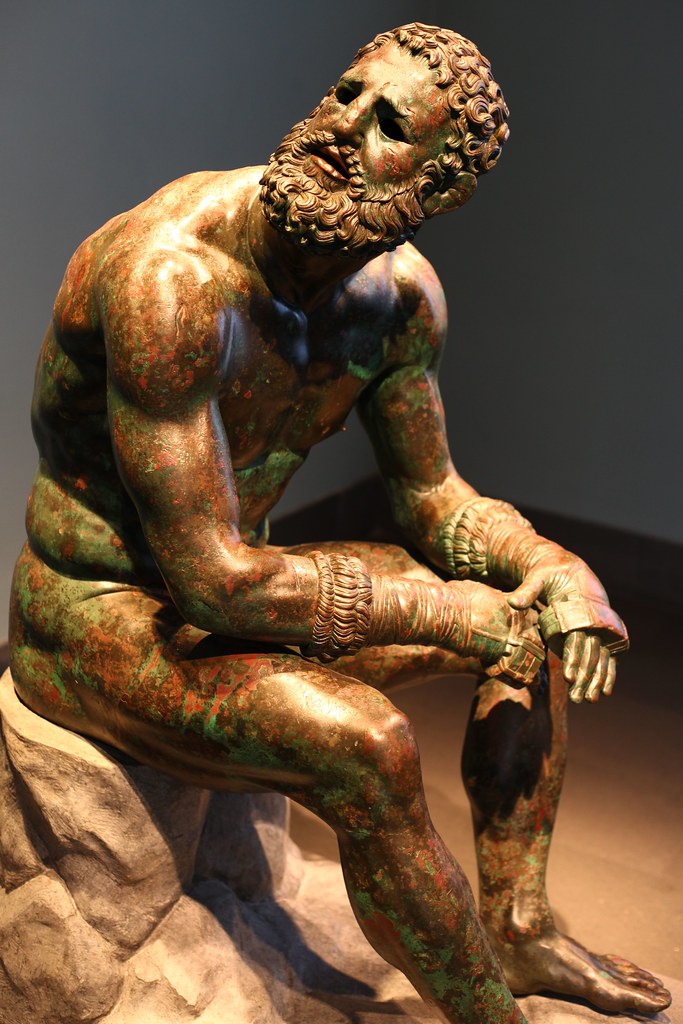
Greek Architecture
Three Types of Greek Temples
Doric
Greeks from mainland Greece preferred this style.
An order of ancient Greek architecture that features grooved columns with no grooved bases and an upper story with square sculpture called metopes
It has simplified capitals and columns with tapered shafts that sit, without a base, directly on the floor of the temple.
Shaft: the body of a column
These have unadorned architraves and alternating triglyphs and metopes, the latter depicting episodes from Greek mythology.
Metope: a small relief sculpture on the façade of a Greek temple
Architrave: a plain, unornamented lintel on the entablature
Ionic
Greek island architects preferred this style.
An order of Greek architecture that features columns with scrolled capitals and an upper story with sculptures that are in friezes
It has volute-like capitals, columns that sit on bases, and friezes of sculpture placed along the entablature.
Entablature: the upper story of a Greek temple
Corinthian
An order of ancient Greek architecture similar to the Ionic, except that the capitals are carved in tiers of leaves
The capitals have leaves and the straight columns have bases that transition to the floor.
Elaborate Greek temple complexes were placed on a high hill, or acropolis, overlooking the city.
Gateways, called propylaea, prepared the visitor for his or her entrance into the complex.
Greek temple architecture shows a reliance on few forms and develops these. And these has two innovations:
The circular shrine, called a tholos, which represents perfection to the geometry-minded Greeks.
The introduction of columns carved as figures, the female version of which are called caryatids.
Temples are built with the post-and-lintel system in mind, the columns are never too widely set apart. The columns completely surround the temple core in a design called a peristyle.
Portico: an entranceway to a building having columns supporting a roof
Pediments: These are seated over the tops of columns, contain sculptures representing the heroic deeds of the god or goddess housed inside.
Cornice: It separates the upper and lower parts of a Greek temple.
➼ Athenian Agora
Details
Archaic through Hellenistic Greek
600–150 B.C.E.
Found in Athens, Greece
Agora: a public plaza in a Greek city where commercial, religious, and societal activities are conducted
Function
A plaza at the base of the Acropolis in Athens with commercial, civic, religious, and social buildings where ceremonies took place.
Setting for the Panathenaic Festival, ceremonies, and parades to honor Athena.
The Panathenaic Way cuts through along a hilly terrain from the northwestern to the southeastern corners.
Content
Bouleuterion: a chamber used by a council of 500 citizens, called a boule, who was chosen by lot to serve for one year.
Tholos: a round structure manned by a group of senators 24 hours a day for emergency meetings; served as a dining hall where the prytaneis (executives) of the boule often met.
Stoas: Covered walkway with columns on one side and a wall on the other.
Images
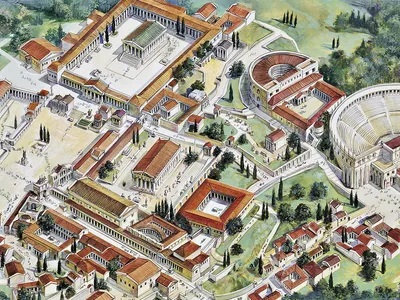
➼ Parthenon
Details
By Iktinos
From The Parthenon
447–410 B.C.E.
Found in Athens, Greece
Form
Greek predilection for algebra and geometry is omnipresent in the design of this building: parts can be expressed as x = 2y + 1; thus, there are 17 columns on the side (x) and 8 columns in the front (y), and the ratio of the length to the width is 9:4. Proportions are the same for the cella.
Cella: the main room of a temple where the god is housed
Unusually light interior had two windows in the cella.
The façade floor curves upward in the center to drain rainwater and prevent sagging at the ends.
Since the end columns are surrounded by light, they are thicker to match the others.
Ionic elements in a Doric temple: the rear room contains Ionic capitals, and the frieze on interior is Ionic.
Function
Interior built to house a massive statue of Athena, to whom the building was dedicated; also included the treasure of the Delian League.
The statue, made of gold and ivory over a wooden core, no longer exists.
Context
Constructed under the leadership of Pericles after the Persian sack of Athens in 480 B.C.E. destroyed the original acropolis.
Pericles used the extra funds in the Persian war treasury to build the Acropolis; Greek allies were furious that the funds were not returned to them.
History
Built as a Greek temple dedicated to Athena, the patroness of Athens.
According to the story, Athena and Poseidon vied for control over Athens and offered gifts to the populace to entice them.
Poseidon made saltwater spring from the ground on the Acropolis. –Athena made an olive tree grow on the site.
The Erechtheum, a temple near the Parthenon, houses Poseidon's trident marks, the salt water well, and the sacred olive tree.
After the Greek period, the Parthenon became a Greek Orthodox church and then a Roman Catholic Mary church.
In the Islamic period, it was converted to a mosque.
Destroyed by the Venetians in an attack against the Turks.
Lord Elgin took half the sculptures to England in the nineteenth century.
Image
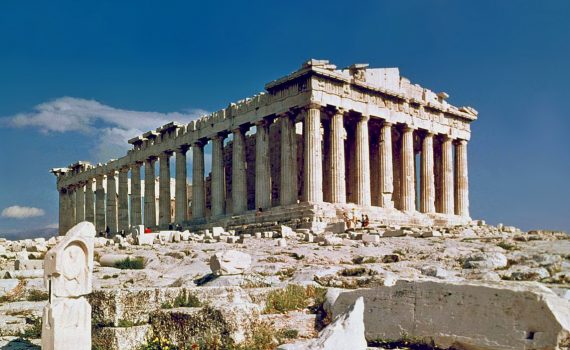
➼ Temple of Athena Nike
Details
By Kallikrates
From Temple of Athena Nike
427–424 B.C.E.
Made up of marble
Found in Athens, Greece
Form
Amphiprostyle: having four columns in the front and four in the back.
Ionic temple.
Function
Built to commemorate the Greek victory over the Persians in the Battle of Marathon; Nike is the goddess of victory.
Once contained a figure of Nike inside.
Context
Many images of victory on the temple.
Cf. Victory adjusting her sandal sculpted on a balustrade or railing that once framed the building.
Image
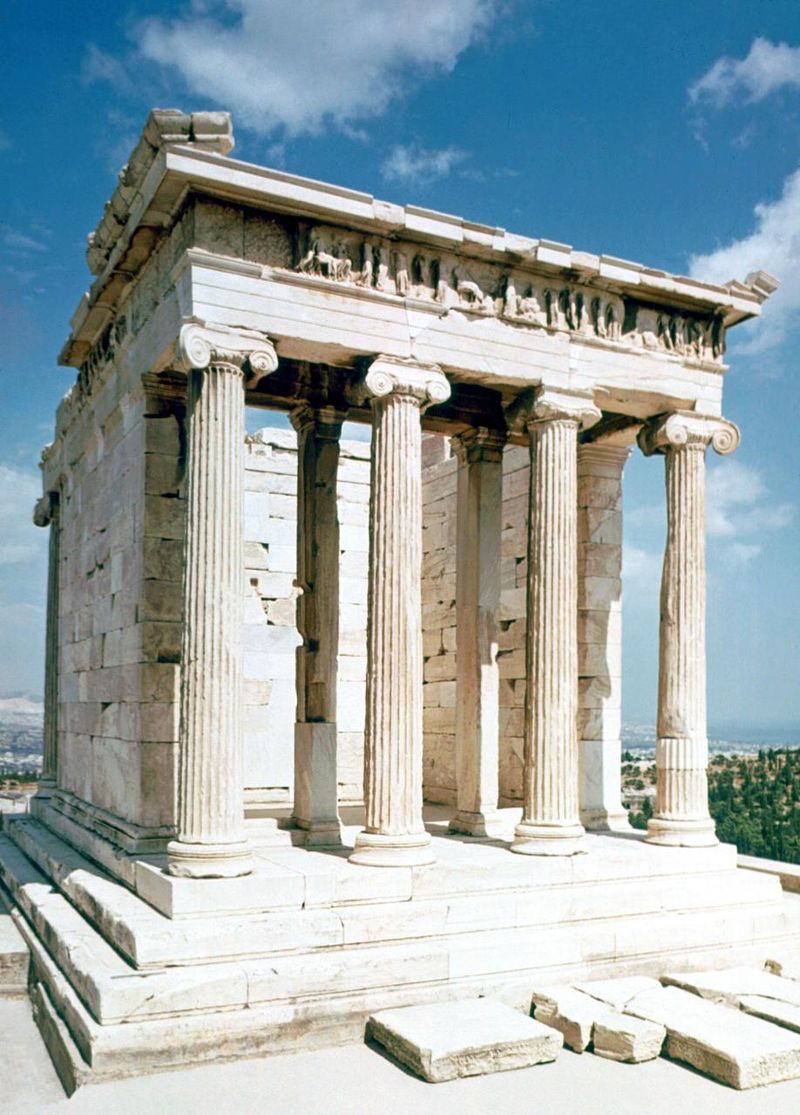
➼ Great Altar of Zeus and Athena at Pergamon
Details
From Asia Minor (present-day Turkey) Hellenistic Greece
c. 175 B.C.E.
Made of marble
Found in Pergamon Museum, Berlin
Form
Altar is on an elevated platform at the top of a dramatic flight of stairs.
A frieze 7.5 feet high and more than 400 feet long wraps around the monument.
Ionic columns frame the monument.
Function
Altar dedicated to Zeus and Athena.
Cf. Athena on the gigantomachy around the base of the altar.
Context
Conscious effort to be in dialogue with the Panathenatic frieze on the Parthenon.
Parallels made between the Pergamon victories over the barbarians in a recent war, Alexander the Great’s defeat of the Persians, and the gods’ defeat of the giants in mythology.
Images
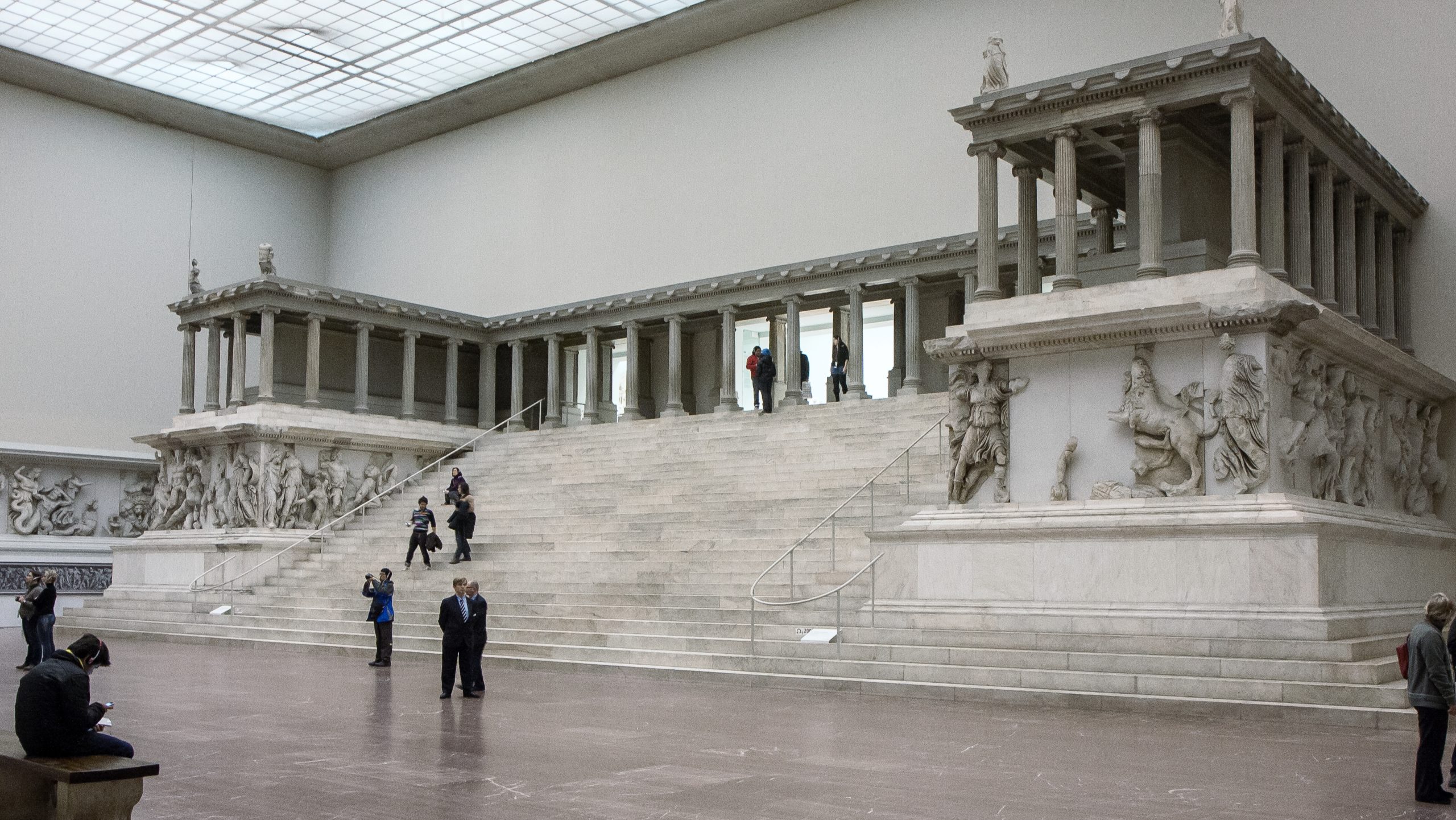
Greek Pottery
Most pots were designed for a particular purpose and were so shaped.
The portable amphora stored provisions like oil or wine with an opening large enough to admit a ladle.
Amphora: a two-handled ancient Greek storage jar
The krater was a bowl for mixing water and wine because the Greeks never drank their wine straight.
A kylix, with its wide mouth and shallow dimensions, was a drinking cup, ideal for the display of scenes on the relatively flat bottom.
In the Archaic period, artists painted in a style called black figure, which emphasized large figures drawn in black on the red natural surface of the clay.
Other colors would burn in the high temperature of the kiln, so after the pot had been fired, details were added in highlighting colors.
Kiln: an oven used for making pottery
The bright glazing of Greek pottery gives the surface a lustrous shine.
At the end of the Archaic period, red-figure vases were introduced by Andokides; in effect, they are the reversal of black figure-style pots.
The backgrounds were painted in black, and the natural red of the clay detailed the forms.
➼ Niobides Krater
Details
Niobid Painter
Classical Greek
460–450 B.C.E.
Made of clay, red-figure technique with white highlights
Found in Louvre, Paris
Form
First time in vase painting that isocephalism (the tradition of depicting heads of figures on the same level) has been jettisoned.
May have been the influence of wall paintings, although almost no Greek wall paintings survive.
Written sources detail how numerous figures were placed at various levels in complex compositions.
Technique: Red figure ware
Function: Ceremonial krater; practical kraters were used for mixing water and wine or storing liquids.
Context
Called the Niobides Krater because the killing of Niobe’s children is depicted on one side.
Niobe, who had seven sons and seven daughters, bragged about her fertility to the god Leto, who had only two children.
Niobe: the model of a grieving mother; after boasting of her fourteen children, jealous gods killed them
Leto’s two children, Apollo and Artemis, sought revenge by killing Niobid’s fourteen.
Niobid is punished for her hubris.
Niobe’s children are slaughtered.
On the other side of the vase, the story is the subject of scholarly debate.
It may depict Herakles in the center with heroes in arms and Athena on the left.
Marathon's warriors may be praying to Herakles for protection in an upcoming battle.
History: Found in Orvieto, Italy; many Greek vases found in Etruscan tombs.
Images
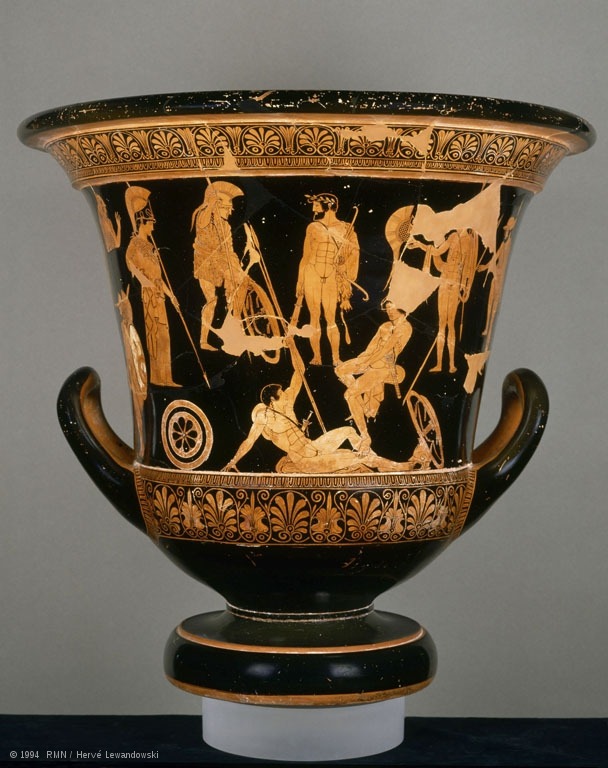
Greek Painting
➼ Alexander Mosaic
Details
From the House of Faun, Republican Roman copy of c. 100 B.C.E.
A mosaic
Found in National Archaeological Museum, Naples
Mosaic: a decoration using pieces of stone, marble, or colored glass, called tesserae, that are cemented to a wall or a floor
Form
Crowded with nervous excitement.
Extremely complex interweaving of figures; spatial illusionism through foreshortening, chiaroscuro, reflection in shield.
Technique
Use of tesserae instead of previously used pebbles.
Tesserae allow for greater flexibility and more complex compositions and shadings.
Function: Roman floor mosaic, found in a house in Pompeii, based on an original Greek mural (?) painting.
Content
Alexander, at left: does not wear a helmet, showing his bravery.
Alexander pierces the body of an enemy with his spear without so much as a glance at his victim.
Alexander’s widened eye is trained on Darius.
Darius, in center right on chariot: horrified, weakly cedes the victory; his charioteer commands the horses to make their escape.
Darius looks stunned as his brother, Oxyanthres, is stabbed, the brother portrayed here as sacrificing himself to save the king.
The dying man’s right hand is still gripping his weapon, as though he wished to pull it out of his body, but his body is already collapsing onto the bloody corpse of his black horse.
Theories
Perhaps a copy of a mural made by Piloxenos of Eretria for King Cassander.
Perhaps made by Helen of Egypt, one of the few female Greek artists whose name has come down to us.
Image
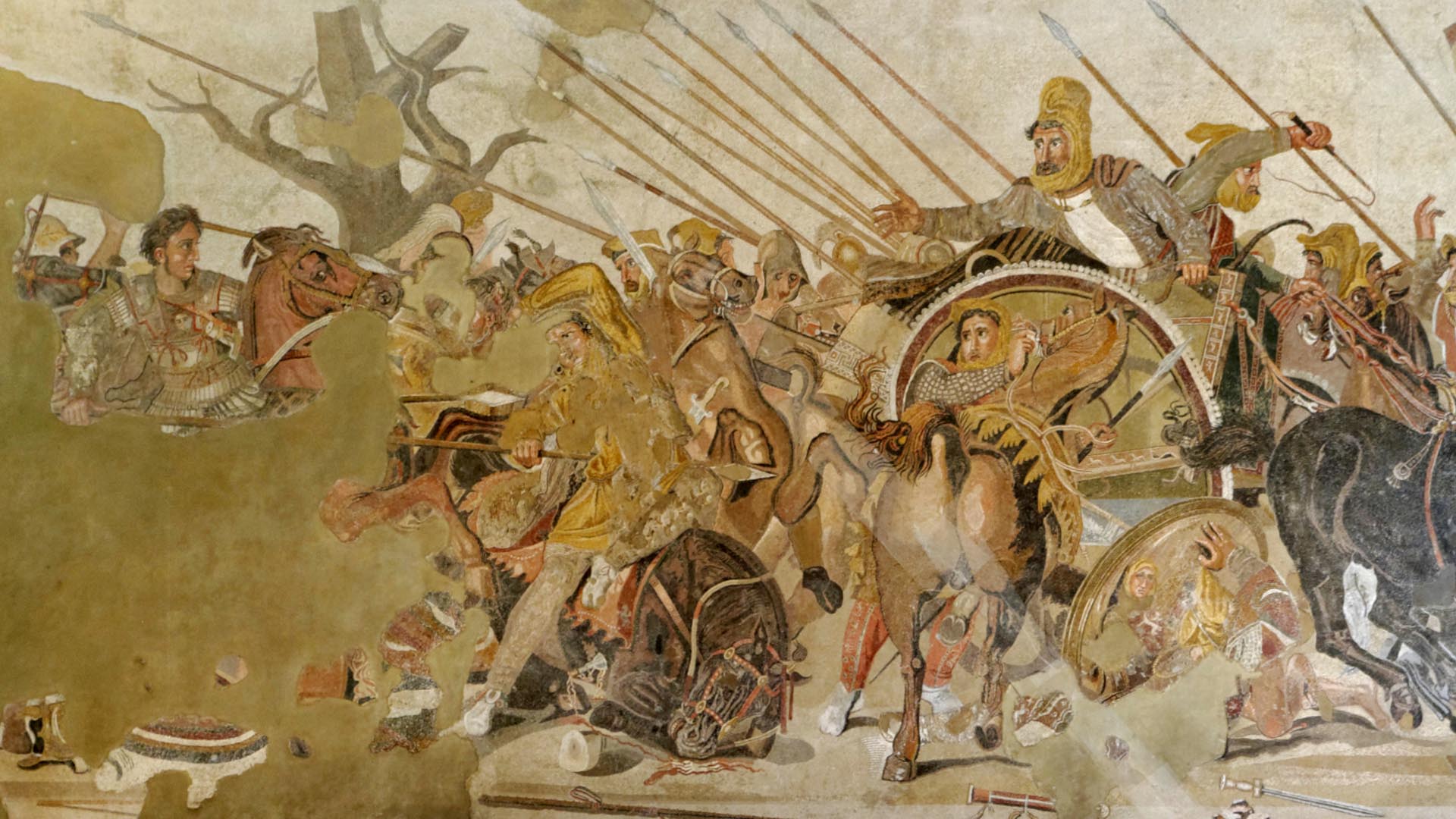
Chapter 4: Greek Art
Key Notes
Time Period
Greek Archaic Art : 600–480 B.C.E.
Greek Classical Art : 480–323 B.C.E.
Greek Hellenistic Art : 323–30 B.C.E.
Culture, beliefs, and physical settings
Ancient Greek art was primarily produced in what is today Greece, Turkey, and Italy.
Greek art is studied chronologically according to changes in style.
Greek culture is rich in written literature: i.e., epics, poetry, dramas.
Greek art is known for its idealization and harmonious proportions, both in sculpture and in architecture.
Cultural Interactions
There is an active exchange of artistic ideas throughout the Mediterranean.
Ancient Greek objects were influenced by Egyptian and Near Eastern works.
Audience, functions and patron
Ancient Greek art is influenced by civic responsibility and the polytheism of its religion.
Theories and Interpretations
The study of art history is shaped by changing analyses based on scholarship, theories, context, and written records.
Greek art has had an important impact on European art, particularly since the eighteenth century.
Greek writing contains some of the earliest contemporary accounts about art and artists.
Historical Background
The collapse of Aegean society around 1100 B.C.E. left a vacuum in the Greek world until a reorganization took place around 900 B.C.E. in the form of city-states.
Places like Sparta, Corinth, and Athens defined Greek civilization in that they were small, competing for political entities that were united only in language and the fear of outsiders.
In the fifth century B.C.E. the Persians threatened to swallow Greece, and the city-states rallied behind Athens’ leadership to expel them.
This was accomplished, but not before Athens itself was destroyed in 480 B.C.E.
After the Persians were effectively neutralized, the Greeks then turned, once again, to bickering among themselves.
The worst of these internal struggles happened during the Peloponnesian War (431–404 B.C.E.) when Athens was crushed by Sparta.
Without an effective core, Greek states continued to struggle for another century.
This did not end until the reign of Alexander the Great, who, in the fourth century B.C.E., briefly united Macedonians and Greeks, by establishing a mighty empire that eventually toppled the Persians.
Because Alexander died young and left no clear successor, his empire crumbled away soon after his death.
The remnants of Greek civilization lasted a few hundred years more until it was eventually absorbed by Rome.
Patronage and Artistic Life
So many names of artists have come down to us that it is tempting to think that Greek artists achieved a distinguished status hitherto unknown in the ancient world.
Artists signed their work, both as a symbol of accomplishment and as a bit of advertisement.
Greek potters and painters signed their vases, usually in a formula that resembles “so and so made it” or “so and so decorated it.”
Many artists were theoreticians as well as sculptors or architects.
Polykleitos: He wrote a famous (no longer existing) book on the canon of human proportions.
Iktinos: He wrote on the nature of ideal architecture.
Phidias He who was responsible for the artistic program on the Acropolis, supervised hundreds of workers in a mammoth workshop and yet still managed to construct a complex with a single unifying artistic expression.
Greek Sculpture
Greek sculpture is unafraid of nudity.
At first, only men are shown as nude; gradually women are also depicted, although there is a reluctance to fully accept female nudity, even at the end of the Greek period.
Large Greek marble sculptures are cut away from the stone behind them.
Large-scale bronze works were particularly treasured; their lighter weight made compositional experiments more ambitious.
Greek art in the Classical and Hellenistic periods use contrapposto, which is a relaxed way of standing with knees bent and shoulders tilted.
Contrapposto: a graceful arrangement of the body based on tilted shoulders and hips and bent knees
Greek Archaic Sculpture
Marble: It is the stone of choice, although Greek works survive in a variety of materials: bronze, limestone, terra cotta, wood, gold—even iron.
Sculpture was often painted, especially if it were to be located high on the temple façade.
Bronze sculpture is hollow and made in the lost-wax process, call cire perdue.
Kouros and kore figures stand frontally, bolt upright, and with squarish shoulders.
Hair is knotted, and the ears are a curlicue.
Figures are cut free from the stone as much as possible, although arms are sometimes attached to thighs.
➼ Anavysos Kouros
Details
From Archaic Greek
c. 530 B.C.E.
A marble with remnants of paint
Found in National Archaeological Museum, Athens
Kouros (female: kore): An archaic Greek sculpture of a standing youth
Form
Emulates the stance of Egyptian sculpture but is nude; arms and legs are largely cut free from the stone.
Rigidly frontal.
Freestanding and able to move; in contrast, many Egyptian works are reliefs or are attached to the stone.
Hair is knotted and falls in neatly braided rows down the back.
Some paint survives, some of it encaustic, which would have given the sculpture greater life.
Encaustic: a type of painting in which colors are added to hot wax to affix to a surface
“Archaic smile” meant to enliven the sculpture.
Function
Grave marker, replacing huge vases of the Geometric period.
Sponsored by an aristocratic family.
Content
Not a real portrait but a general representation of the dead.
Named after a young military hero, Kroisos; the inscription at the base identifies him: “Stand and grieve at the tomb of Kroisos, the dead, in the front line slain by the wild Ares.”
Image

➼ Peplos Kore
Details
From the Acropolis, Archaic Greek
c. 530 B.C.E.
A marble and painted details
Found in Acropolis Museum, Athens
Peplos: a garment worn by women in ancient Greece, usually full length and tied at the waist
Form
Hand emerges into the viewer’s space, breaks out of the mold of static Archaic statues.
Indented waist.
Breasts revealed beneath drapery.
Rounded and naturalistic face.
Much of the encaustic paint still remains, animating the face and hair.
Broken hand was fitted into the socket and probably held an attribute; she may have been a goddess.
Context: She is named for the peplos, thought to be one of the four traditional garments she is wearing.
Theory
Recent theory proposes that she is the goddess, either Athena or Artemis; the figure is now missing arrows and a bow in her hand, and she may have worn a metal diadem on her head.
Image

Greek Classical Sculpture
Contrapposto: The fluid body movement and relaxed stance that was unknown in freestanding sculpture before this.
In the fifth century B.C.E., this heroic form was defined by Polykleitos, a sculptor whose canon of proportions of the human figure had far-reaching effects.
Canon: a body of rules or laws; in Greek art, the ideal mathematical proportion of a figure
He wrote that the head should be one-seventh of the body.
He preferred heavy musculature with alternating relaxed and stressed muscle stances.
On Spear Bearer (450–440 B.C.E.), the right arm and the left leg are flexed, and the left arm and right leg are relaxed.
In the Late Classical period of the fourth century B.C.E., gods were sculpted in a more humanized way.
Praxiteles, the greatest sculptor of his age, carved figures with a sensuous and languorous appeal and favored a lanky look to the bodies.
➼ Doryphoros (Spear Bearer)
Details
A sculpture of Polykleitos
original: c. 450–440 B.C.E.
A Roman marble copy of a Greek bronze original,
Found in National Archaeological Museum, Naples
Form
Blocky solidity.
Closed stance.
Broad shoulders, thick torso, muscular body.
Idealized body; contrapposto.
Body is both tense and relaxed: left arm and right leg are relaxed, right arm and left leg are tense.
Content
Warrior and athlete.
Hand once held a spear.
Movement is restrained; ideal Spartan body.
Averted gaze; he does not recognize the viewer’s admiration.
Contemplative gaze.
Context: Represents Polykleitos’s ideal masculine figure.
History
Marble Roman copy of a bronze Greek original.
Found in Pompeii in a place for athletic training, perhaps for inspiration for athletes.
Image

➼ Helios, Horses, and Dionysus (Heracles?)
Details
c. 438–432 B.C.E.
Made up of marble
Found in British Museum, London
Form
Greek Classical art; contrapposto.
Figures seated in the left-hand corner of the east pediment of the Parthenon
Sculptures comfortably sit in the triangular space of the pediment.
Function
Part of the east pediment of the Parthenon.
This grouping contains figures who are present at the birth of Athena, which is the main topic at the center of pediment—now lost.
Content
On the left, the sun god, Helios, bringing up the dawn with his horses; the male nude is Dionysus, god of wine, and he is lounging.
Two seated figures may be the goddesses Demeter and Persephone, reacting to the birth of Athena.
Context
Part of the Parthenon sculptures, also called the Elgin Marbles.
Phidias acted as the chief sculptor of the workshop.
Image

➼ Plaque of the Ergastines
Details
c. 447–438 B.C.E.
Made up of marble
Found in Louvre, Paris
Form
Isocephalism: the tradition of depicting heads of figures on the same level.
Figures stand in contrapposto.
Carved in high relief, which reflects placement; the more three-dimensional the relief, the better it could be seen from below.
Content: Six ergastines, young women in charge of weaving Athena’s peplos, are greeted by two priests.
Context
Part of a frieze from the Parthenon that depicts some 360 figures.
Frieze: a horizontal band of sculpture
Scene from the Panathenaic Frieze depicting the Panathenaic Procession, held every four years to honor Athena.
Panathenaic Way: a ceremonial road for a procession built to honor Athena during a festival
This is the first time in Greek art that human events are depicted on a temple.
The scene contains a religious procession of women dressed in contemporary drapery and acting nobly.
The procession began at the Dipylon Gate, passed through the agora, and ended at the Parthenon.
Athenians placed new peplos on an ancient statue of Athena.
Theory: Not the Panathenaic procession but the story of the legendary Athenian king Erechtheus, who sacrificed one of his daughters to save the city of Athens; told to do so by the Oracle of Delphi.
Image

➼ Victory Adjusting Her Sandal
Details
From the Temple of Athena Nike
c. 410 B.C.E.
Made up of marble
Found in Acropolis Museum, Athens
Nike: ancient Greek goddess of victory
Form
Graceful winged figure modeled in high relief.
Deeply incised drapery lines reveal body; wet drapery.
Context
Part of the balustrade on the Temple of Athena Nike, a war monument.
One of many figures on the balustrade; not a continuous narrative but a sequence of independent scenes.
The importance of military victories was stressed in the images on the Acropolis.
Image

➼ Grave Stele of Hegeso
Details
Attributed to Kallimachos
c. 410 B.C.E.
Made up of marble and paint
Found in National Archaeological Museum, Athens
Stele: an upright stone slab used to mark a grave or a site
Form
Classical period of Greek art.
Use of contrapposto in the standing figure.
Jewelry painted in, not visible.
Architectural framework.
Text includes name of the deceased.
Function
Grave marker.
In Geometric and Archaic periods, Greeks used kraters and kouroi to mark graves; in the Classical period, stelae were used.
Content
Commemorates the death of Hegeso; an inscription identifies her and her father.
Genre scene is that Hegeso examines a piece of jewelry from a jewelry box handed to her by a standing servant; may represent her dowry.
Standing figure has a lower social station, placed before a seated figure.
Context
Erected in the Dipylon cemetery in Athens.
Attributed to the sculptor Kallimachos.
Image

Greek Hellenistic Sculpture
Figures have a great variety of expressions from sadness to joy.
Themes untouched before, such as childhood, old age, despair, anger, and drunkenness, are common subjects in Hellenistic art.
➼ Winged Victory of Samothrace
Details
Hellenistic Greek
c. 190 B.C.E.
Made up of marble
Found in Louvre, Paris
Form
Monumental figure.
Dramatic twist and contrapposto of the torso.
Wet drapery look imitates water playing on the wet body.
Illusion of wind on the body.
Function: Meant to sit on a fountain representing a figurehead on a boat; the fountain would splash water around the figure.
Content
Large heroic figure of Nike placed above the marble prow of a naval vessel.
Nike is wearing several garments, some of which are folded inside out to show the force of the wind.
Nike may have held a trumpet, wreath, or fillet in her right hand. However, the hand found in Samothrace in 1950 has an open palm and two outstretched fingers, indicating that she was simply greeting.
Context
Probably made to commemorate a naval victory in 191 B.C.E.; Nike is the goddess of victory.
The boat at the base is an ancient battleship with oar boxes and traces of a ram.
History
Found in 1863 in situ on Samothrace.
Reassembled in the Louvre Museum in Paris and placed at the top of a grand staircase.
Only one wing was found; the other is a mirror image.
Only one breast was found; the other is a reconstruction.
The right hand has been found, but it cannot be attached because no arms have been found.
Image

➼ Athena, from the Great Altar of Zeus and Athena at Pergamon
Details
Hellenistic Greek
c. 175 B.C.E.
Made up of marble
Found in Pergamon Museum, Berlin
Athena: Greek goddess of war and wisdom; patron of Athens
Zeus: King of the ancient Greek gods; known as Jupiter to the Romans; god of the sky and weather
Form
Deeply carved figures overlap one another; masterful handling of spatial illusion; figures break into the viewer’s space from the frieze.
Dramatic intensity of figures and movement; heroic musculature.
Function
Gigantomachy on the base of the Pergamon Altar illustrates the victories of the goddess Athena, who is worshipped at the altar.
Gigantomachy: a mythical ancient Greek war between the giants and the Olympian gods
Content
Describes the battle between the gods and the giants; the giants, depicted as helpless, are dragged up the stairs to worship the gods.
Athena grabs Alkyoneos by the hair and drags him up the stair to worship Zeus.
Nike, on the right, crowns Athena in victory.
Gaia, the earth goddess, looks on in horror and pleads for the fate of her sons, the giants.
Context
The gods’ victory over the giants offers a parallel to Alexander the Great’s defeat of the Persians.
Also acts as an allegory of a Greek military victory by Eumenes II.
Image

➼ Seated Boxer
Details
Hellenistic Greek
c. 100 B.C.E.
Made up of bronze
Found in National Roman Museum, Rome
Form
Older man, past his prime, looks defeated.
Smashed nose; lips sunken in suggesting broken teeth.
Cauliflower ears.
Nude fighter; hands wrapped in leather bands.
Figure evinces sadness, stoicism and determination.
Function: May have been a good luck charm for athletes; evidence of toes worn away from being touched.
Materials
Rare surviving Hellenistic bronze.
Blood, denoted in copper, drips from his face and onto his right arm and thigh.
Copper used to highlight his lips and nipples, the straps on his leather gloves, and the wounds on his head.
Context
May have been part of a group or perhaps a single sculpture, the head turned to face an unseen opponent.
Found in a Roman bath in Rome.
Image

Greek Architecture
Three Types of Greek Temples
Doric
Greeks from mainland Greece preferred this style.
An order of ancient Greek architecture that features grooved columns with no grooved bases and an upper story with square sculpture called metopes
It has simplified capitals and columns with tapered shafts that sit, without a base, directly on the floor of the temple.
Shaft: the body of a column
These have unadorned architraves and alternating triglyphs and metopes, the latter depicting episodes from Greek mythology.
Metope: a small relief sculpture on the façade of a Greek temple
Architrave: a plain, unornamented lintel on the entablature
Ionic
Greek island architects preferred this style.
An order of Greek architecture that features columns with scrolled capitals and an upper story with sculptures that are in friezes
It has volute-like capitals, columns that sit on bases, and friezes of sculpture placed along the entablature.
Entablature: the upper story of a Greek temple
Corinthian
An order of ancient Greek architecture similar to the Ionic, except that the capitals are carved in tiers of leaves
The capitals have leaves and the straight columns have bases that transition to the floor.
Elaborate Greek temple complexes were placed on a high hill, or acropolis, overlooking the city.
Gateways, called propylaea, prepared the visitor for his or her entrance into the complex.
Greek temple architecture shows a reliance on few forms and develops these. And these has two innovations:
The circular shrine, called a tholos, which represents perfection to the geometry-minded Greeks.
The introduction of columns carved as figures, the female version of which are called caryatids.
Temples are built with the post-and-lintel system in mind, the columns are never too widely set apart. The columns completely surround the temple core in a design called a peristyle.
Portico: an entranceway to a building having columns supporting a roof
Pediments: These are seated over the tops of columns, contain sculptures representing the heroic deeds of the god or goddess housed inside.
Cornice: It separates the upper and lower parts of a Greek temple.
➼ Athenian Agora
Details
Archaic through Hellenistic Greek
600–150 B.C.E.
Found in Athens, Greece
Agora: a public plaza in a Greek city where commercial, religious, and societal activities are conducted
Function
A plaza at the base of the Acropolis in Athens with commercial, civic, religious, and social buildings where ceremonies took place.
Setting for the Panathenaic Festival, ceremonies, and parades to honor Athena.
The Panathenaic Way cuts through along a hilly terrain from the northwestern to the southeastern corners.
Content
Bouleuterion: a chamber used by a council of 500 citizens, called a boule, who was chosen by lot to serve for one year.
Tholos: a round structure manned by a group of senators 24 hours a day for emergency meetings; served as a dining hall where the prytaneis (executives) of the boule often met.
Stoas: Covered walkway with columns on one side and a wall on the other.
Images

➼ Parthenon
Details
By Iktinos
From The Parthenon
447–410 B.C.E.
Found in Athens, Greece
Form
Greek predilection for algebra and geometry is omnipresent in the design of this building: parts can be expressed as x = 2y + 1; thus, there are 17 columns on the side (x) and 8 columns in the front (y), and the ratio of the length to the width is 9:4. Proportions are the same for the cella.
Cella: the main room of a temple where the god is housed
Unusually light interior had two windows in the cella.
The façade floor curves upward in the center to drain rainwater and prevent sagging at the ends.
Since the end columns are surrounded by light, they are thicker to match the others.
Ionic elements in a Doric temple: the rear room contains Ionic capitals, and the frieze on interior is Ionic.
Function
Interior built to house a massive statue of Athena, to whom the building was dedicated; also included the treasure of the Delian League.
The statue, made of gold and ivory over a wooden core, no longer exists.
Context
Constructed under the leadership of Pericles after the Persian sack of Athens in 480 B.C.E. destroyed the original acropolis.
Pericles used the extra funds in the Persian war treasury to build the Acropolis; Greek allies were furious that the funds were not returned to them.
History
Built as a Greek temple dedicated to Athena, the patroness of Athens.
According to the story, Athena and Poseidon vied for control over Athens and offered gifts to the populace to entice them.
Poseidon made saltwater spring from the ground on the Acropolis. –Athena made an olive tree grow on the site.
The Erechtheum, a temple near the Parthenon, houses Poseidon's trident marks, the salt water well, and the sacred olive tree.
After the Greek period, the Parthenon became a Greek Orthodox church and then a Roman Catholic Mary church.
In the Islamic period, it was converted to a mosque.
Destroyed by the Venetians in an attack against the Turks.
Lord Elgin took half the sculptures to England in the nineteenth century.
Image

➼ Temple of Athena Nike
Details
By Kallikrates
From Temple of Athena Nike
427–424 B.C.E.
Made up of marble
Found in Athens, Greece
Form
Amphiprostyle: having four columns in the front and four in the back.
Ionic temple.
Function
Built to commemorate the Greek victory over the Persians in the Battle of Marathon; Nike is the goddess of victory.
Once contained a figure of Nike inside.
Context
Many images of victory on the temple.
Cf. Victory adjusting her sandal sculpted on a balustrade or railing that once framed the building.
Image

➼ Great Altar of Zeus and Athena at Pergamon
Details
From Asia Minor (present-day Turkey) Hellenistic Greece
c. 175 B.C.E.
Made of marble
Found in Pergamon Museum, Berlin
Form
Altar is on an elevated platform at the top of a dramatic flight of stairs.
A frieze 7.5 feet high and more than 400 feet long wraps around the monument.
Ionic columns frame the monument.
Function
Altar dedicated to Zeus and Athena.
Cf. Athena on the gigantomachy around the base of the altar.
Context
Conscious effort to be in dialogue with the Panathenatic frieze on the Parthenon.
Parallels made between the Pergamon victories over the barbarians in a recent war, Alexander the Great’s defeat of the Persians, and the gods’ defeat of the giants in mythology.
Images

Greek Pottery
Most pots were designed for a particular purpose and were so shaped.
The portable amphora stored provisions like oil or wine with an opening large enough to admit a ladle.
Amphora: a two-handled ancient Greek storage jar
The krater was a bowl for mixing water and wine because the Greeks never drank their wine straight.
A kylix, with its wide mouth and shallow dimensions, was a drinking cup, ideal for the display of scenes on the relatively flat bottom.
In the Archaic period, artists painted in a style called black figure, which emphasized large figures drawn in black on the red natural surface of the clay.
Other colors would burn in the high temperature of the kiln, so after the pot had been fired, details were added in highlighting colors.
Kiln: an oven used for making pottery
The bright glazing of Greek pottery gives the surface a lustrous shine.
At the end of the Archaic period, red-figure vases were introduced by Andokides; in effect, they are the reversal of black figure-style pots.
The backgrounds were painted in black, and the natural red of the clay detailed the forms.
➼ Niobides Krater
Details
Niobid Painter
Classical Greek
460–450 B.C.E.
Made of clay, red-figure technique with white highlights
Found in Louvre, Paris
Form
First time in vase painting that isocephalism (the tradition of depicting heads of figures on the same level) has been jettisoned.
May have been the influence of wall paintings, although almost no Greek wall paintings survive.
Written sources detail how numerous figures were placed at various levels in complex compositions.
Technique: Red figure ware
Function: Ceremonial krater; practical kraters were used for mixing water and wine or storing liquids.
Context
Called the Niobides Krater because the killing of Niobe’s children is depicted on one side.
Niobe, who had seven sons and seven daughters, bragged about her fertility to the god Leto, who had only two children.
Niobe: the model of a grieving mother; after boasting of her fourteen children, jealous gods killed them
Leto’s two children, Apollo and Artemis, sought revenge by killing Niobid’s fourteen.
Niobid is punished for her hubris.
Niobe’s children are slaughtered.
On the other side of the vase, the story is the subject of scholarly debate.
It may depict Herakles in the center with heroes in arms and Athena on the left.
Marathon's warriors may be praying to Herakles for protection in an upcoming battle.
History: Found in Orvieto, Italy; many Greek vases found in Etruscan tombs.
Images

Greek Painting
➼ Alexander Mosaic
Details
From the House of Faun, Republican Roman copy of c. 100 B.C.E.
A mosaic
Found in National Archaeological Museum, Naples
Mosaic: a decoration using pieces of stone, marble, or colored glass, called tesserae, that are cemented to a wall or a floor
Form
Crowded with nervous excitement.
Extremely complex interweaving of figures; spatial illusionism through foreshortening, chiaroscuro, reflection in shield.
Technique
Use of tesserae instead of previously used pebbles.
Tesserae allow for greater flexibility and more complex compositions and shadings.
Function: Roman floor mosaic, found in a house in Pompeii, based on an original Greek mural (?) painting.
Content
Alexander, at left: does not wear a helmet, showing his bravery.
Alexander pierces the body of an enemy with his spear without so much as a glance at his victim.
Alexander’s widened eye is trained on Darius.
Darius, in center right on chariot: horrified, weakly cedes the victory; his charioteer commands the horses to make their escape.
Darius looks stunned as his brother, Oxyanthres, is stabbed, the brother portrayed here as sacrificing himself to save the king.
The dying man’s right hand is still gripping his weapon, as though he wished to pull it out of his body, but his body is already collapsing onto the bloody corpse of his black horse.
Theories
Perhaps a copy of a mural made by Piloxenos of Eretria for King Cassander.
Perhaps made by Helen of Egypt, one of the few female Greek artists whose name has come down to us.
Image

 Knowt
Knowt
